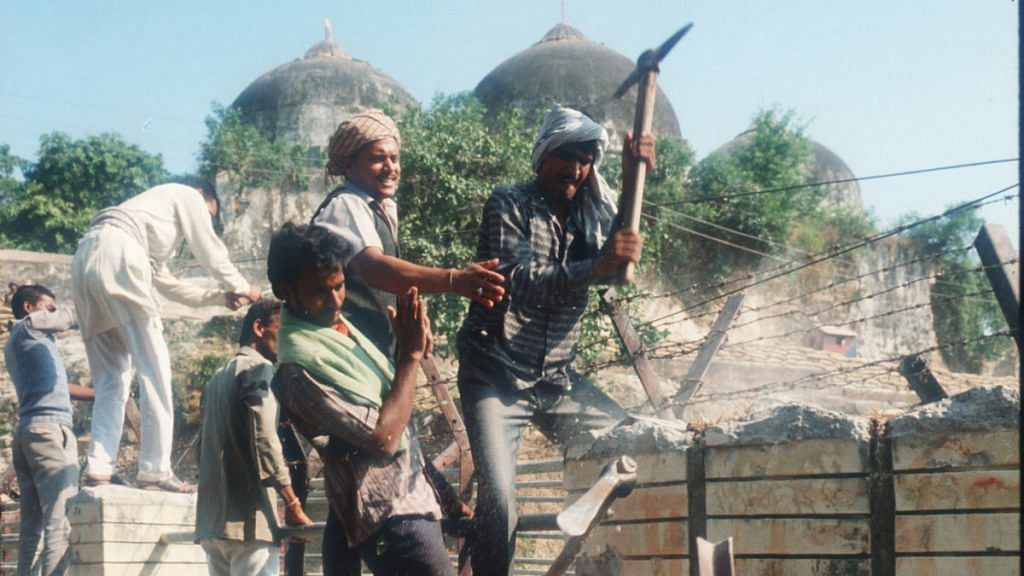The Ayodhya issue has seen 14 prime ministers and several legislations, but the solution won’t come from govt or judiciary.
With the Supreme Court deferring the crucial case of Ram Mandir-Babri Masjid dispute to January 2019 saying that an appropriate bench would be constituted to hear the matter, the chorus for Parliament legislation and an ordinance have increased. The RSS has publically suggested that the Ayodhya issue can be resolved only through enacting an appropriate law in Parliament.
The Supreme Court was hearing petitions challenging the Allahabad High Court verdict, which ruled that the disputed land in Ayodhya be divided into three parts. The Ayodhya Ram Janmabhoomi case, spanning nearly seven decades and surviving the Mughal and the British Raj, has seen 14 prime ministers since Independence. Prime Minister Narendra Modi is the first prime minister born after Independence who is now seized of the Ayodhya issue. Of course, he is neither new to the issue nor an outsider to the agitation to build a temple at the disputed site.
Also read: Explained- All things Babri, Faruqui and Ayodhya
More than three crore cases are pending in Indian courts, and the Babri Masjid-Ram Mandir issue is one among them.
Never before in the history of court battles had a small piece of land measuring 2.77 acres been subjected to so much legal, social and political upheavals as the Ayodhya land, where supposedly a temple was destroyed and a mosque built by Mir Baqi, believed to be Babur’s army chief, in 1528. In 1991, the government of Uttar Pradesh acquired the land around the structure for the convenience of devotees coming to worship in the Ram Temple. Some say that the place was not being used by the local Muslims to offer prayers. On 6 December 1992, the dilapidated structure (Babri Masjid) was demolished by the Kar Sevaks.
The Union government under PM Narasimha Rao went into damage control mode and brought out a law called “The Acquisition of Certain Area at Ayodhya Act, 1993”. Through this Act, the central government acquired all rights of property whether movable or immovable in and around the Ram Janmabhoomi-Babri Masjid complex. Section 4 (2) and (3) of the Act specified that on the commencement of this Act, “any suit, appeal or other proceeding in any respect of the right, title and interest relating to any property, which was thus vested in the central government, pending before any court, tribunal or any other authority, shall abate”.
Besides, the Act in Section 6(1) also provided that the central government can hand over some or any extent of the land to any authority, body, trustees of any trust set up on or after the takeover of these areas, for any activity or construction as the government may deem fit. The Act was challenged, but the Supreme Court in 1994 upheld the Act. However, it struck down Section 4 (3), thereby reviving all the litigations and asserting the supremacy of the judiciary over legislature to decide the fate of the cases.
Also read: SC is right, no need to rush through Ayodhya verdict
Surprisingly, subsequent governments decided to fight the cases in court rather than wrest control of the issue in Parliament.
Interestingly, there is also an argument that the 1993 Act can be amended by Parliament and included under the Ninth Schedule of the Constitution. Once a law is enacted and included in the Ninth Schedule, it gets protection under Article 31-B (validation of certain Acts and Regulations) and is not subject to judicial scrutiny.
The Ninth Schedule, the first amendment, was introduced by PM Jawaharlal Nehru to keep certain agrarian laws, particularly those on land reforms, beyond the scope of judicial review. But subsequently, in 1973, the Supreme Court through a nine-bench judgment ruled that the insertion of a bill in the Ninth Schedule is not controlled by any defined criteria by which the exercise of power may be evaluated. The insertion of the Ninth Schedule nullifies Part 3 of the Constitution that deals with fundamental rights. And there is no Constitutional control over it. The Supreme Court thus ruled that the supremacy of the Constitution mandates a mechanism be set up to test the validity of legislative acts through an independent organ—the judiciary.
Also read: Ayodhya issue may not linger beyond 2019 elections
Thus, the option of resolving the Ayodhya issue through a bill in Parliament does not enjoy judicial immunity. The demand for an ordinance also is not an easy option as it will require the President of India to issue it only if the situation so warrants. Again, any such ordinance will have to be ratified by Parliament within six months and cannot be promulgated during the session. With the 2019 elections approaching, Parliament will be in session for less than six months. Also, the ordinance itself can be challenged in court thus bringing two Constitutional authorities, the office of the President of India and the Supreme Court in direct confrontation.
The Ayodhya issue is no longer a religious one. And it has now gone beyond the confines of Parliament and the courts. It is now only up to the sane elements of the country to come to a negotiated settlement. But they are an endangered species in India today.
The author is former editor of ‘Organiser’.
